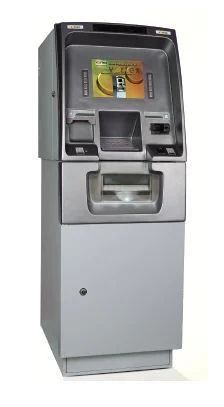(This post is a slightly edited version of my answer to the above Quora question.)
Equating the cash handling capabilty of a vending machine with that of an ATM is like saying a shovel and 80 feet container are the same because they both handle loads.
Most vending machines only accept coins. The few that take notes accept only one note per consumer and don’t have to count notes. They dispense the ordered product and change, if they’re capable of doing that. They do not issue a receipt. They do not post any transaction on a remote server.
 On the other hand, a cash accepting ATM machine – also called Bunch Note Acceptor or Cash Deposit Machine – needs to be designed to handle a huge number of currency notes because it caters primarily to deposits from small businesses dealing in cash (When was the last time you’ve seen a private individual depositing cash into an ATM? I thought so too).
On the other hand, a cash accepting ATM machine – also called Bunch Note Acceptor or Cash Deposit Machine – needs to be designed to handle a huge number of currency notes because it caters primarily to deposits from small businesses dealing in cash (When was the last time you’ve seen a private individual depositing cash into an ATM? I thought so too).
A friendly neightborhood store collects around INR 50K in cash per day, which translates into 200+ bills across various denominations.
After it accepts such a high volume of currency notes, the BNA / CDM machine needs to recognize the denomination of each note, count the number of notes of each denomination in the deposit, total up the deposit, post the credit on the customer’s account at the remote core banking system server, and issue a receipt to the depositor. It needs to do all this within seconds.
All of that requires a lot of gear. Therefore, a bank needs to invest a lot of money to install a cash deposit machine.
In my many decades of selling technology to banks, if there’s one thing that hasn’t changed much, it’s that banks will spend money on computer hardware and software only if they get adequate return on their investments.
The business case for BNA comes from headcount reduction at branch caused by moving cash deposit activity from tellers at branch to the BNA. To secure its ROI, a bank needs to make sure that there’s adequate usage of the machine. Otherwise, it might be cheaper for the bank to continue with cash deposit arrangement at its tellers and tell customers to visit the branch to deposit cash even if that’s inconvenient for them. Notwithstanding the lip service they pay to the outside world around customer-centricity, banks rarely invest in technology just to enhance user experience and customer experience – unlike fintechs who often do so just to deliver a superior UX and CX. More at Why Banks Will Never Catch Up With Fintechs On UX.
Of course, no bank will talk about headcount reduction publicly. Instead it will resort to platitudes – which have also not changed much in decades – that it’s deploying technology to free up its staff to focus on more strategic activities.
Tired: ERP automates transactions, thus freeing up people to focus on strategy.
Wired: AI automates strategy, thus freeing up people to focus on transactions.
Any guesses what AI-enabled ERP will free up people to focus on? https://t.co/73mhy205nx— Ketharaman Swaminathan (@s_ketharaman) February 14, 2024
But I digress.
As for the spread of BNAs, I’ve personally never had the need to deposit cash in an ATM and have never gone looking for a BNA, but I can speculate. I recently received an SMS from a bank that its BNA network would be down for a couple of hours the following day. Since I don’t have any relationship with this bank, I’m guessing this was spam. But my takeaway from this is that if a bank feels the need to tell randos about its cash deposit machines, it probably has a fairly wide network of those machines that justifies spreading the word around far and wide.


